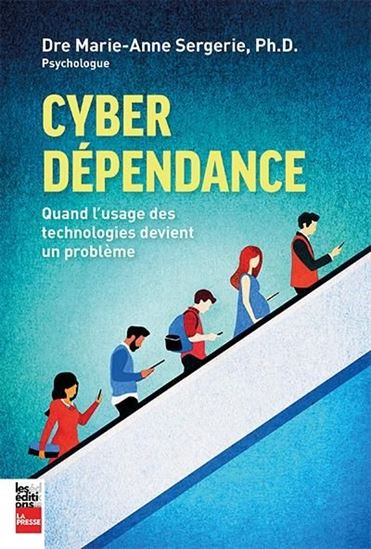Young people engage in doom … what?
Young people engage in doom … what?
Based on an interview with Marie-Anne Sergerie, psychologist and author
Doomscrolling! A word that doesn’t readily slip off the tongue, but which keeps many teenagers actively engaged with their devices. What is this worrying new habit that may make young people more anxious? How should a parent react? Marie-Anne Sergerie, a psychologist and expert in cyberaddiction, sheds some light on this phenomenon.
Here are a few quiz questions that will help you better understand doomscrolling:

QUESTION 1: What is the French translation of doomscrolling?
A. Défilement morbide
B. Défilement de pertes
C. Défilement vers le bas
D. The word doomscrolling is accepted in French because it cannot be translated
ANSWER: A
« Défilement morbide is the translation recommended by the Office de la langue française », explains psychologist and author Marie-Anne Sergerie. But it’s more the Anglicism “scroller” that young people tend to use instead of the verb “défiler”.

QUESTION 2: What does doomscrolling consist of?
A. Using their tablet to scroll through videos of their classmates filmed without their knowledge.
B. Sending videos of teachers after making them angry.
C. Spending an excessive amount of time scrolling repeatedly through negative news.
D. Sending texts containing long lists of dangerous challenges to try.
ANSWER: C
« The problem arises when the scrolling behaviour is repeated so often that it resembles a compulsion. It is important to remember that people engage in compulsive behaviour to relieve a pre-existing feeling of unease. It is therefore a defence strategy that people use to numb themselves, a bit like drugs do. But it’s short-lived relief.
With doomscrolling, the compulsion comes on top of the fact that the information chosen is already very negative in itself. For example, it could be bad news about war or violence on news sites or fake news on social media or even posts glorifying depression and suicidal thoughts.
And the more you see of it, the truer it appears to be. In fact, the brain takes shortcuts to induce certain beliefs. So, yes, it can have an impact on mental health by increasing distress and anxiety.
It’s as though the person found themself in an endless spiral. – Marie-Anne Sergerie
QUESTION 3 – TRUE OR FALSE: There’s a specific age when this compulsive disorder begins, and it is between the ages of 11 or 12.
ANSWER: False
« There is no accurate data about age. Anyway, the most important thing is to identify what’s going on, not based on a certain age, but rather through the behaviour and distress that accompany the user. In young people, the main indicator is that their behaviour becomes uncontrollable when they no longer have access to their cell phone or tablet. »

QUESTION 4: But then what should a parent do if their child throws a fit when the parent tries to confiscate their phone?
A. Give the phone back to them.
B. Tell them that if they continue, you’ll simply cancel the phone service with the telephone company.
C. Quickly walk away with the phone to keep the situation from degenerating.
D. Say nothing, hand the phone back to them, but cancel the phone plan.
ANSWER: Well, this was a trick answer because, in fact, none of these actions are recommended.
« Well, of course, if you give the phone back to them after they have a fit, there will certainly be many more in the future. But in this situation, the first thing to do isn’t to confiscate the device, but rather to understand that this behaviour just raised a big, a very big, red flag. Something’s not right and it’s time to communicate with your teen to find out what is really going on. »
What should you do if you notice these signs in your child? What attitude should you take to fight this harmful habit? 🤔

« It’s important to prioritize a dialogue with your child », states the psychologist.
👉 You can first explain to them what doomscrolling is and raise their awareness of the risks that this behaviour can have on their well-being. Then you can ask them questions such as:
- What do you like to do on your phone?
- How do you feel when you go on these applications?
- When you’re not doomscrolling, what do you think about?
- What causes you to feel stress?
- How much time do you spend every day doing this activity?
- How are your relationships with other people?
- Do you feel more isolated than before?
The question about how much time they spend on this behaviour is very important. You can talk to your child to establish rules together and apply healthy phone use management.
« The goal here is not to deprive them of their device, but to agree on a responsible usage strategy that avoids excess. For example, ensuring that family meals aren’t spent looking at a screen. And ensuring as well that everyone puts their phones away for the night. An agreement could be reached about a place to charge phones overnight that is far from the bedrooms. »
Did you know? 3 in 4 teens connect to social media first thing in the morning.
Yeah, for sure, man, the first thing I do in the morning is grab my phone. But I’m not addicted. Anyway, I don’t think I am… ⸺ Casquette (the nickname he gave us), age 16.
Then, try to fill the void by offering them other options. Some parents have struck deals like: you have to spend as many hours doing sports or volunteer work as you spend on the internet. You can set the example during a family outing where everyone’s cell phones stay turned off. Or sign them up for an activity that seems to interest them.
« Lastly, concludes the expert, if you know how to spice up young people’s lives with something more than just the internet, I have a feeling that they won’t be opposed to trying these new experiences. Because their brains, so young and full of space, are really able to absorb them. »

Discover the author’s book
Cyberdépendance : quand l’usage des technologies devient un problème – Marie-Anne Sergerie
Devenu incontournable, Internet s’est immiscé dans notre quotidien et a modifié nos habitudes de vie au point d’avoir des impacts considérables. Pour certaines personnes, trouver un équilibre reste un défi ! À quel moment l’usage des nouvelles technologies devient-il un problème ? Comment comprendre l’apparition de la cyberdépendance ? De quelles façons se manifeste-t-elle ? Quels sont les différentstypes de cyberdépendance ? Comment la prévenir ? L’objectif principal de cet ouvrage est d’accompagner et d’aider les gens qui s’interrogent sur leur utilisation des technologies.
BUY THE BOOK ↗
Content offered by our partner
Our mission: to provide support to parents!
Since 2016, Aidersonenfant.com has provided parents concrete, high-quality content free of charge to enable them to better support their children both emotionally and socially, as well as in their academic trajectory. Like social pediatrics, our approach is interdisciplinary.
Everything is connected!
Made up of a solid team of education professionals, our experts have mastered the art of popularizing content (texts, podcasts and web conferences) to make it accessible to everyone. We are committed to equipping and supporting parents of school and preschool-aged children to help them make a significant difference in the progress of their child.